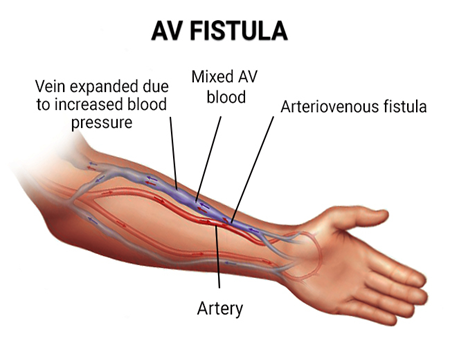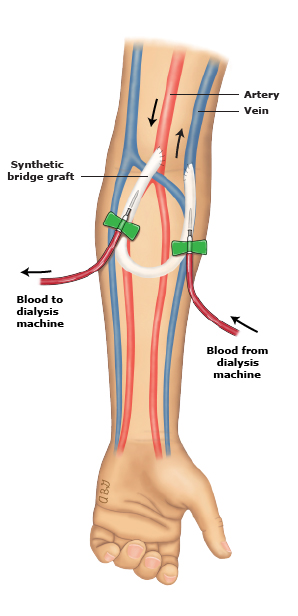What Does A Dialysis Access Do?
Simply stated, a dialysis access provides a way to reach your blood during dialysis for cleaning.
There are two dialysis methods used to treat kidney failure: hemodialysis and peritoneal dialysis. Hemodialysis uses a man-made membrane (a dialyzer) to filter the blood and return it to the body. Peritoneal dialysis uses the inner lining of the abdomen and a sterile solution to filter the blood and remove toxins. Each type of dialysis requires a different way to gain access to your body (in the case of peritoneal dialysis), or your blood for a hemodialysis treatment.
During hemodialysis, a dialysis access allows blood to travel from your body through the arterial blood line to a machine. Connected to is a dialyzer, sometimes referred to as an artificial kidney, and this is where blood is cleaned and then returned to your body through a venous bloodline. While the dialysis machine performs the work of your kidneys, the access serves as the pathway to your blood. (i)
During peritoneal dialysis (PD), an exchange of fluids through a catheter is how the dialysis treatment is achieved . PD is a type of dialysis that uses a person’s peritoneum, the lining of your abdomen, as the filter. A cleaning solution, known as dialysate, absorbs waste and excess fluid from your blood. A peritoneal dialysis (PD) catheter placed in the wall of your abdomen is how the dialysate enters and exits your body.
Different types of Heamodialysis access
here are Three dialysis access types.
- Arteriovenous Fistula (AVF)
- Arteriovenous (AV) Graft
- Central Venous Catheter (CVC)

After surgery, the blood flow in the vein or fistula will increase, which will eventually increase the diameter of the vein and the thickness of the vein wall; the increase in blood flow in the vein is necessary for the maturation of the fistula. The time for maturation ranges from 3 weeks to 3 months. In the event that the fistula fails to mature, additional procedure may be required like balloon fistulopasty or creation of a new fistula. When the fistula is mature, a large calibre needle can be used to puncture the vein for dialysis treatment.
Arteriovenous (AV) GraftGraft: a prosthetic tube is implanted into the patient, which will connect the vein and the artery.
Picture below showing sample one of the AVfistula graft.

Central Venous Catheter is most often used as temporary access for hemodialysis. The CVC is placed into a large vein, usually in your neck or upper chest or femoral vein near to the groin area. The tip of the CVC rests in the upper right chamber of your heart while the other end of the catheter remains outside of your body. The external portion of the catheter consists of two plastic limbs. One limb is responsible for removing the blood from your body while the other limb returns the cleaned blood to your body.
There are significant disadvantages to CVC access in comparison to fistulas or grafts. With a CVC, there is an increased risk of serious infection as well as clotting, and you are unable to take a bath or shower without a proper cover over the catheter exit site while it is in place.
The hemodialysis process is slightly different with a catheter than fistulas or grafts. There is no need for needles to take the blood to and from the dialysis system. Dialysis tubing is attached directly to the limbs of your catheter for transport through the dialysis machine.
Following below guidelines will help you avoid infection, blood clots, and other problems with your vascular access.
- Always wash your hands with soap and warm water before and after touching your access. Clean the area around the access with antibacterial soap or rubbing hand rub solutions before your dialysis treatments.
- Check the flow (also called thrill) in your access every day. Your provider will show you how.
- Do not let anyone take your blood pressure, start an IV (intravenous line), or draw blood from your access arm.
- Do not let anyone draw blood from your tunneled central venous catheter.
- Do not sleep on your access arm.
- Do not carry more than 5.0 kg with your access arm.
- Do not wear a watch, jewelry, or tight clothes over your access site.
- Be careful not to bump or cut your access.
- Use your access only for dialysis.